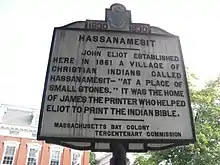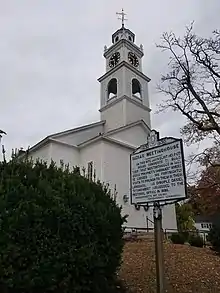Praying town
Praying towns were developed by the Puritans of New England from 1646 to 1675 in an effort to convert the local Native American tribes to Christianity.[1] The Natives who moved into these towns were known as Praying Indians. Before 1674 the villages were the most ambitious experiment in converting Native Americans to Christianity in the Thirteen Colonies.[1] John Eliot learned Massachusett and first preached to the Natives in their own language in 1646 at Nonantum, meaning "place of rejoicing." Newton developed here. This sermon led to a friendship with Waban, who became the first Native American in Massachusetts to convert to Christianity.[2]

Purpose

The idea behind the praying towns was that Natives would convert to Christianity and also adopt European customs and farming techniques. They were expected to give up their hunter-gatherer lifestyle, clothing, rituals, and anything else that the colonists considered "uncivilized." The Massachusetts General Court recognized the work of Eliot and helped to establish additional praying towns.
Fourteen praying towns
Between 1651 and 1675, the court created 14 praying towns, but only Natick and Punkapoag had full church status with independent congregations.[3]
Some prominent praying towns in the Massachusett area were Gay Head, Christiantown (Okokammeh), Nantucket, Natick, Mashpee, Wamesit (Lowell/Chelmsford), Hassanamisco (Grafton), Herring Pond (Plymouth) and Nukkehkummees (Dartmouth).[4] Three praying towns were established in Connecticut: Maanexit (Nipmuc word meaning "where we gather") is believed to have been located at the site of present-day Fabyan (Thompson, CT), Quinnatisset (meaning "little long river") was located six miles south of Maanexit, and Wabaquasset (meaning "mats for covering the house") was taken over by the development of present-day Woodstock, Connecticut.[1] These three towns held between 100 and 150 Nipmuc tribal members.
After King Philip's War in 1677, the General Court disbanded 10 of the original 14 towns. They placed the rest under the supervision of colonists.[3] Many communities did survive and retained their own religious and education systems.[4]
Comparison to Jesuits in Canada
The idea of a full conversion was in strong contrast to the approach of the Catholic Jesuits in Canada. They worked to add Christianity to the Natives' existing beliefs, as opposed to replacing them. They learned Native American languages and found ways to relate Christian principles to their existing religions (as was also done by Catholic missionaries in China.)[5] While some Natives were quick to take on the conversion, some did not like the idea of a full conversion. The process was not always an easy one, and there were many reasons for some to undertake conversion.
Refuge from war
Some Natives converted because they believed it might increase their legitimacy in the eyes of the colonists and thus recognition of their rights to their land. Because of internal troubles among the tribes, and between the colonists and the tribes, some of the Native Americans considered the praying towns as refuges from warfare. Other tribes had been all but destroyed from disease and famine, and possibly looked to Christianity and the Puritan way of life as an answer to their suffering, when their traditional beliefs did not seem to have helped them. Other Natives joined the towns because they had no other option economically or politically.[5]
Failed assimilation
While praying towns had some successes, they never reached the level which John Eliot had hoped for. The Puritans were pleased with the conversions, but Praying Indians were still considered second-rate citizens and never gained the degree of trust or respect from colonists which they had hoped conversion would grant them. It has also been argued that the Natives had a difficult time adjusting to the impersonal society of colonial America, since theirs had been built upon relationships and reciprocity, while that of the colonists were more structured and institutionalized. According to this view, this difference made it hard for Natives to see the institutionalized structures as a whole, and John Eliot had failed to see the need for adaptations appropriate for smoother transitions.[5]
Self-governing

Other historians have noted that the Praying Indian communities exercised self-government by electing their own rulers and officials. This system exhibited a degree of continuity with their pre-contact social system. While English-style offices, such as constables and Justices of the Peace were introduced, they were often designated with names identical to those of traditional Native American offices. The elected officials were often chosen from the ranks of the traditional tribal aristocracy; there were cases of native hereditary rulers remaining in power. The communities also used their own languages as the language of administration, producing an abundance of legal and administrative documents that survive to this day. However, their self-government was gradually curtailed in the course of the 18th and 19th centuries, and their languages eventually became extinct. Most of the original "Praying Towns" declined due to epidemics and to the loss of communal land property during the centuries after their foundation.[4]
References
- The Praying Towns
- http://www.wabanimprovement.org/oldsite/waban%20early%20days/wabanwind.html
- Praying Towns, Blackwell Reference Online
- Goddard, Ives and Kathleen J. Bragdon (eds.) (1989) Native Writings in Massachusett. Philadelphia: American Philosophical Society, pp. 2-15.
- ' "That Art of Coyning Christians:" John Eliot and the Praying Indians of Massachusetts,' John Eliot and Kenneth M. Morrison, Ethnohistory, Vol. 21, No. 1 (Winter, 1974), pp. 77-92